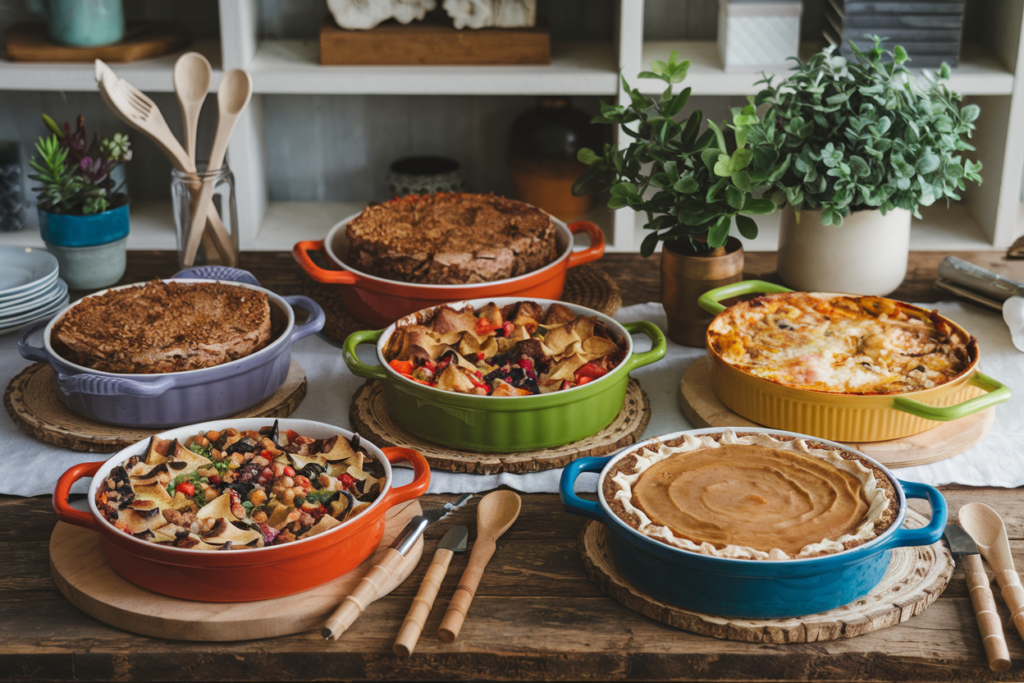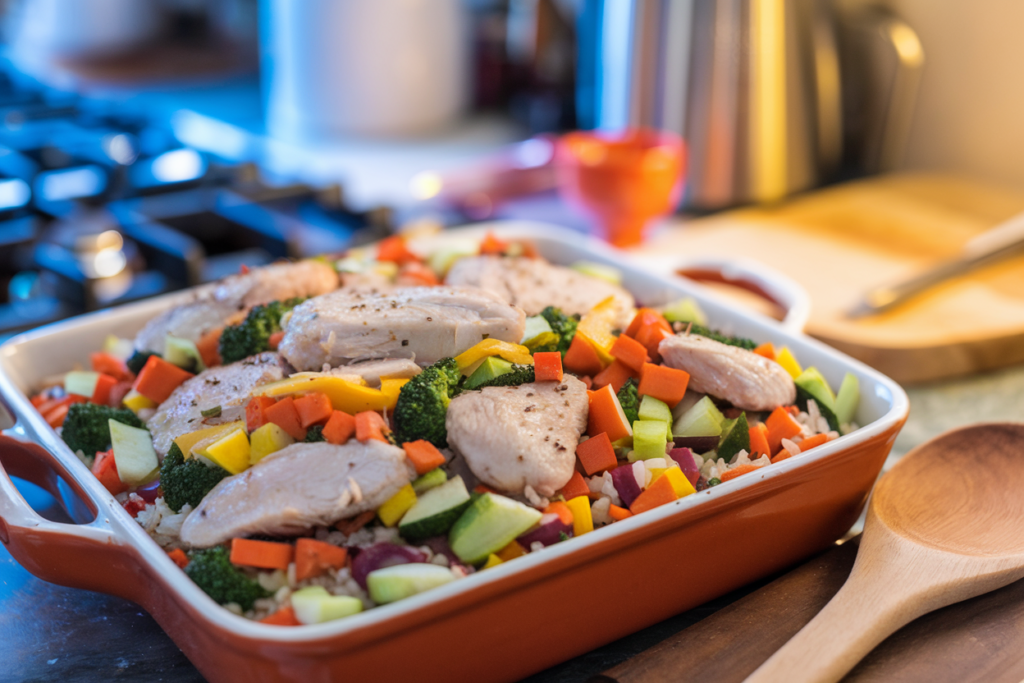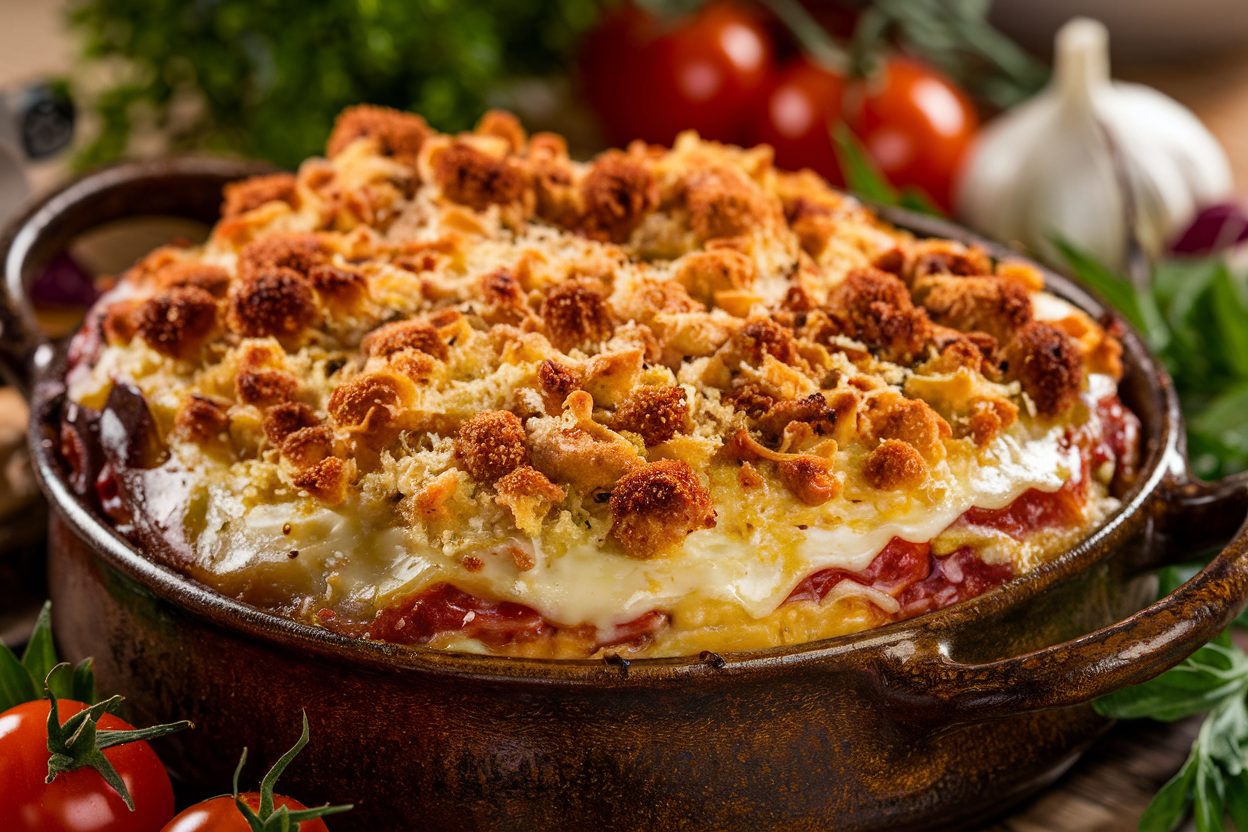Have you ever wondered what really makes a casserole… well, a casserole? Is it the ingredients, the dish, or the technique? Let’s uncover the secrets of this timeless comfort food!
Introduction to Casseroles
Casseroles are more than just food—they’re a culinary tradition steeped in history and heart. Whether it’s a cheesy lasagna, a hearty tuna bake, or a creamy chicken pot pie, casseroles have a way of bringing people together.
The Origins of Casseroles
The word “casserole” comes from the French term for a deep, ovenproof dish. This cooking method has been around for centuries, but the modern casserole we know today really took shape in the 20th century when convenience foods like canned soups and pre-cooked ingredients made it easier for families to whip up hearty meals.
Cultural Variations of Casseroles
Did you know casseroles take on different forms around the world? In America, we have classics like green bean casserole. Over in Italy, lasagna reigns supreme, while in France, dishes like Gratin Dauphinois showcase creamy layers of potatoes. Each culture adds its unique spin, making casseroles as diverse as the people who create them.
Defining a Casserole: Key Characteristics
So, what sets a casserole apart from, say, a stew or a stir-fry? It’s all in the details.
Ingredients That Make a Casserole
At its core, a casserole typically includes:
- A Base: Starches like pasta, rice, or potatoes create the foundation.
- Protein: Think chicken, beef, tofu, or seafood.
- Vegetables: Broccoli, carrots, mushrooms—you name it.
- A Binding Agent: Creamy sauces, eggs, or cheese hold it all together.
- Toppings: Breadcrumbs, shredded cheese, or crushed crackers add that perfect finish. 🧀
The Role of the Baking Dish
The casserole dish itself is essential. Usually deep and oven-safe, it allows ingredients to cook evenly while the flavors meld together. Without it, your dish might lack that signature casserole magic.
Cooking Techniques Unique to Casseroles
Casseroles are all about the bake. Slow cooking in the oven ensures that the flavors combine harmoniously while creating that golden crust on top. It’s like a symphony for your taste buds!
Common Types of Casseroles
Casseroles come in all shapes and flavors, so there’s something for everyone.
Meat-Based Casseroles
From chicken and rice casseroles to beef stroganoff bakes, these dishes are packed with protein and perfect for hearty appetites.
Vegetarian and Vegan Casseroles
Plant-based eaters, rejoice! Dishes like lentil bakes or sweet potato casseroles are rich, filling, and packed with nutrients. 🥦
Breakfast Casseroles
Who says casseroles are just for dinner? Breakfast casseroles—loaded with eggs, cheese, and veggies—are a morning game-changer.

Dessert Casseroles
Yes, dessert casseroles are a thing! Think bread pudding or fruit cobblers, baked to sweet perfection.
“Casseroles are the culinary equivalent of a warm hug—simple, satisfying, and full of love.”
What Makes a Great Casserole?
Crafting the perfect casserole isn’t just about tossing ingredients together—it’s an art form. Let’s explore what takes a casserole from good to unforgettable.
Balancing Flavors and Textures
The best casseroles are a harmony of flavors and textures. Think about it: a creamy base paired with crunchy toppings, savory proteins balanced by sweet or tangy elements. Without this balance, your casserole might end up tasting one-dimensional. So, next time you’re cooking, ask yourself—does this dish have a little bit of everything?
Importance of Layering Ingredients
Layering is the secret weapon for a stellar casserole. It ensures every bite delivers a blend of flavors. Start with a sturdy base, follow with proteins and veggies, then seal the deal with your binding sauce. Repeat as needed. The result? A beautifully cohesive dish where all the ingredients shine.
The Secret to the Perfect Crust or Topping
What’s a casserole without a golden, crispy topping? Breadcrumbs, shredded cheese, or even crushed potato chips can add the perfect finishing touch. Here’s a tip: lightly spray your topping with oil before baking for that irresistible crunch. 🧀✨
Elevate Your Casserole Game with Restaurant-Style Flavor Hacks
One of the secrets to crafting a truly unforgettable casserole lies in the details—balancing flavors, layering ingredients, and using simple techniques to enhance taste. If you’ve ever wondered how to make your dishes taste like they came straight from a gourmet kitchen, incorporating some restaurant-style flavor hacks is key.
For instance, much like spaghetti can be transformed with the right seasoning and sauce techniques, as explained in How Do You Make Spaghetti Taste Like a Restaurant?, casseroles can benefit from these same principles. A dash of fresh herbs, a squeeze of citrus, or even roasting your vegetables before baking can add depth and sophistication to your dish.
Don’t forget the power of a well-made sauce—it acts as the backbone of your casserole, much like a perfectly seasoned marinara does for spaghetti. Experiment with high-quality ingredients and don’t be afraid to step outside the box with spices or unique toppings. Want your casserole to taste five-star-worthy? It’s all about the little things that make a big difference.
Common Problems When Making Casseroles
Even seasoned cooks encounter casserole challenges. Here are some common issues and how to solve them.
Why Does My Casserole Turn Out Soggy?
A soggy casserole can ruin your meal, but don’t worry—it’s fixable! The culprit is often too much liquid. Use pre-cooked ingredients when possible, and drain veggies like zucchini or mushrooms that release water during cooking.
How to Fix a Bland Casserole
Nobody wants a flavorless casserole. Spice it up! Use fresh herbs, spices, or a splash of acid (like lemon juice or vinegar) to bring life to your dish. Remember, seasoning every layer is key.
Preventing Burnt Tops and Undercooked Centers
Burnt tops and undercooked centers are a common frustration. To prevent this, cover your casserole with foil for the first half of baking, then uncover it for the final 10-15 minutes to achieve that perfect crust.
The Versatility of Casseroles
Casseroles are the ultimate flexible dish. Whether you’re accommodating dietary restrictions or using up leftovers, they adapt to your needs.
How Casseroles Adapt to Different Dietary Needs
From gluten-free to keto, casseroles can cater to any diet. Swap traditional noodles for zucchini spirals or rice for cauliflower. You can also use dairy-free cheeses and plant-based proteins for a vegan-friendly version.

Using Leftovers to Create a New Dish
Got leftovers? Turn them into a casserole! Last night’s roast chicken and veggies can easily transform into a creamy chicken bake. It’s a creative way to reduce food waste and enjoy something new.
Table: Ingredients and Quantities for a Classic Chicken Casserole
| Ingredient | Quantity |
|---|---|
| Chicken breast (cooked) | 2 cups, shredded |
| Rice (cooked) | 2 cups |
| Cream of mushroom soup | 1 can (10 oz) |
| Broccoli (chopped) | 1 cup |
| Shredded cheddar cheese | 1 cup |
| Breadcrumbs | 1/2 cup |
| Milk | 1/4 cup |
“Cooking a casserole is like building a house—the layers are your foundation, and the topping is the roof that ties it all together.”
Popular Casserole Recipes Around the World
Casseroles are truly a global dish, each culture adding its unique spin. Let’s explore some popular recipes that highlight the diversity and creativity of casseroles.
Classic American Tuna Casserole
The American tuna casserole is a nostalgic favorite. It combines pantry staples like canned tuna, egg noodles, and cream of mushroom soup, topped with crispy breadcrumbs. It’s quick, affordable, and oh-so-comforting. Perfect for weeknight dinners!
French Gratin Dauphinois
France’s Gratin Dauphinois is a creamy, luxurious casserole made with thinly sliced potatoes, heavy cream, and garlic. The simplicity of the ingredients allows the flavors to shine. It’s a perfect side dish but can easily take center stage.
Italian Lasagna
Lasagna is Italy’s gift to casserole lovers. Layers of pasta, rich tomato sauce, creamy béchamel, and melted cheese make this dish a crowd-pleaser. Whether it’s meat-based or vegetarian, lasagna never disappoints.
Asian-Inspired Casserole Ideas
Casseroles aren’t traditionally associated with Asian cuisine, but fusion recipes like a teriyaki chicken rice bake or a Thai-inspired curry casserole bring bold, exciting flavors to the table. Don’t be afraid to experiment!
Healthier Casserole Options
Casseroles can sometimes get a bad rap for being calorie-dense, but with a few tweaks, they can be both nutritious and delicious.
Substituting Ingredients for a Lighter Meal
Simple swaps can make a world of difference:
- Use Greek yogurt instead of heavy cream.
- Swap white rice for quinoa for extra protein.
- Try lean meats like turkey or tofu instead of ground beef.
Gluten-Free and Low-Carb Casserole Ideas
Going gluten-free or low-carb? No problem! Use cauliflower rice, zucchini noodles, or even spaghetti squash as your base. Pair it with your favorite proteins and veggies for a dish that fits your lifestyle.
Table: Nutrition Comparison (Classic vs. Healthier Chicken Casserole)
| Nutrient | Classic | Healthier Version |
|---|---|---|
| Calories | 450 kcal | 320 kcal |
| Protein | 25 g | 30 g |
| Carbohydrates | 40 g | 18 g |
| Fats | 18 g | 10 g |
| Fiber | 3 g | 5 g |
Tips for Perfecting Your Casserole Every Time
Even with all the right ingredients, a few pro tips can take your casserole game to the next level.
Prepping Ingredients for Better Results
Pre-cook your proteins and parboil starchy bases like pasta or potatoes. This ensures everything cooks evenly and avoids a soggy casserole.
Cooking Times and Temperature Guidelines
A good rule of thumb is to bake casseroles at 350°F (175°C) for about 30–45 minutes. Check for bubbling edges and a golden top as signs it’s done.
Serving and Storing Casseroles
Casseroles taste even better the next day! Store leftovers in an airtight container in the fridge for up to three days or freeze them for longer. Reheat in the oven to maintain that crispy topping.
“A casserole isn’t just a meal—it’s a gift that keeps on giving, even as leftovers!”
Conclusion: Why Casseroles Are a Timeless Dish
Casseroles have stood the test of time for good reason. They’re versatile, comforting, and easy to prepare. Whether you’re feeding a crowd, catering to dietary needs, or simply using up leftovers, there’s a casserole for every occasion. So, grab your baking dish, get creative, and start layering your way to casserole perfection!

